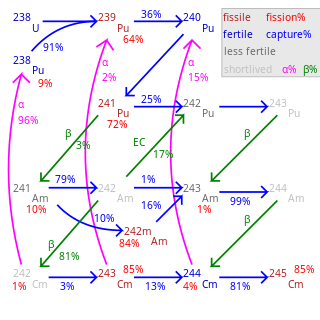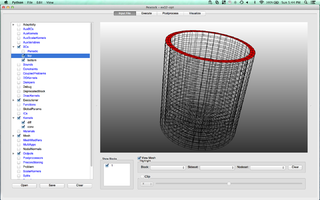Related Research Articles

The neutron is a subatomic particle, symbol
n
or
n0
, which has a neutral charge, and a mass slightly greater than that of a proton. Protons and neutrons constitute the nuclei of atoms. Since protons and neutrons behave similarly within the nucleus, and each has a mass of approximately one atomic mass unit, they are both referred to as nucleons. Their properties and interactions are described by nuclear physics.
Monte Carlo methods, or Monte Carlo experiments, are a broad class of computational algorithms that rely on repeated random sampling to obtain numerical results. The underlying concept is to use randomness to solve problems that might be deterministic in principle. They are often used in physical and mathematical problems and are most useful when it is difficult or impossible to use other approaches. Monte Carlo methods are mainly used in three problem classes: optimization, numerical integration, and generating draws from a probability distribution.

Neutron transport is the study of the motions and interactions of neutrons with materials. Nuclear scientists and engineers often need to know where neutrons are in an apparatus, what direction they are going, and how quickly they are moving. It is commonly used to determine the behavior of nuclear reactor cores and experimental or industrial neutron beams. Neutron transport is a type of radiative transport.
Monte Carlo N-Particle Transport (MCNP) is a general-purpose, continuous-energy, generalized-geometry, time-dependent, Monte Carlo radiation transport code designed to track many particle types over broad ranges of energies and is developed by Los Alamos National Laboratory. Specific areas of application include, but are not limited to, radiation protection and dosimetry, radiation shielding, radiography, medical physics, nuclear criticality safety, detector design and analysis, nuclear oil well logging, accelerator target design, fission and fusion reactor design, decontamination and decommissioning. The code treats an arbitrary three-dimensional configuration of materials in geometric cells bounded by first- and second-degree surfaces and fourth-degree elliptical tori.
Plutonium (94Pu) is an artificial element, except for trace quantities resulting from neutron capture by uranium, and thus a standard atomic weight cannot be given. Like all artificial elements, it has no stable isotopes. It was synthesized long before being found in nature, the first isotope synthesized being 238Pu in 1940. Twenty plutonium radioisotopes have been characterized. The most stable are plutonium-244 with a half-life of 80.8 million years, plutonium-242 with a half-life of 373,300 years, and plutonium-239 with a half-life of 24,110 years. All of the remaining radioactive isotopes have half-lives that are less than 7,000 years. This element also has eight meta states; all have half-lives of less than one second.

The minor actinides are the actinide elements in used nuclear fuel other than uranium and plutonium, which are termed the major actinides. The minor actinides include neptunium, americium, curium, berkelium, californium, einsteinium, and fermium. The most important isotopes of these elements in spent nuclear fuel are neptunium-237, americium-241, americium-243, curium-242 through -248, and californium-249 through -252.
Nuclear data represents measured probabilities of various physical interactions involving the nuclei of atoms. It is used to understand the nature of such interactions by providing the fundamental input to many models and simulations, such as fission and fusion reactor calculations, shielding and radiation protection calculations, criticality safety, nuclear weapons, nuclear physics research, medical radiotherapy, radioisotope therapy and diagnostics, particle accelerator design and operations, geological and environmental work, radioactive waste disposal calculations, and space travel calculations.

Weapons-grade nuclear material is any fissionable nuclear material that is pure enough to make a nuclear weapon or has properties that make it particularly suitable for nuclear weapons use. Plutonium and uranium in grades normally used in nuclear weapons are the most common examples.
The EGS computer code system is a general purpose package for the Monte Carlo simulation of the coupled transport of electrons and photons in an arbitrary geometry for particles with energies from a few keV up to several hundreds of GeV. It originated at SLAC but National Research Council of Canada and KEK have been involved in its development since the early 80s.
Plutonium-240 is an isotope of plutonium formed when plutonium-239 captures a neutron. The detection of its spontaneous fission led to its discovery in 1944 at Los Alamos and had important consequences for the Manhattan Project.
FLUKA is a fully integrated Monte Carlo simulation package for the interaction and transport of particles and nuclei in matter. FLUKA has many applications in particle physics, high energy experimental physics and engineering, shielding, detector and telescope design, cosmic ray studies, dosimetry, medical physics, radiobiology. A recent line of development concerns hadron therapy.
In nuclear power technology, burnup is a measure of how much energy is extracted from a primary nuclear fuel source. It is measured as the fraction of fuel atoms that underwent fission in %FIMA or %FIFA as well as, preferably, the actual energy released per mass of initial fuel in gigawatt-days/metric ton of heavy metal (GWd/tHM), or similar units.

A traveling-wave reactor (TWR) is a proposed type of nuclear fission reactor that can convert fertile material into usable fuel through nuclear transmutation, in tandem with the burnup of fissile material. TWRs differ from other kinds of fast-neutron and breeder reactors in their ability to use fuel efficiently without uranium enrichment or reprocessing, instead directly using depleted uranium, natural uranium, thorium, spent fuel removed from light water reactors, or some combination of these materials. The concept is still in the development stage and no TWRs have ever been built.
The iodine pit, also called the iodine hole or xenon pit, is a temporary disabling of a nuclear reactor due to buildup of short-lived nuclear poisons in the reactor core. The main isotope responsible is 135Xe, mainly produced by natural decay of 135I. 135I is a weak neutron absorber, while 135Xe is the strongest known neutron absorber. When 135Xe builds up in the fuel rods of a reactor, it significantly lowers their reactivity, by absorbing a significant amount of the neutrons that provide the nuclear reaction.
FASTRAD is a tool dedicated to the calculation of radiation effects on electronics. The interface includes a 3D modeler with all the capabilities required for the representation of any system. Application areas include: high energy physics and nuclear experiments, medical, accelerator and space physics studies. The software is used by radiation engineers around the world.

RELAP5-3D is a simulation tool that allows users to model the coupled behavior of the reactor coolant system and the core for various operational transients and postulated accidents that might occur in a nuclear reactor. RELAP5-3D can be used for reactor safety analysis, reactor design, simulator training of operators, and as an educational tool by universities. RELAP5-3D was developed at Idaho National Laboratory to address the pressing need for reactor safety analysis and continues to be developed through the United States Department of Energy and the International RELAP5 Users Group (IRUG) with over $3 million invested annually. The code is distributed through INL's Technology Deployment Office and is licensed to numerous universities, governments, and corporations worldwide.
The Virtual Instrumentation Tool for the ESS (VITESS) is an open source software package for the simulation of neutron scattering experiments. The software is maintained and developed by the Helmholtz-Zentrum Berlin für Materialien und Energie (HZB), the former Hahn-Meitner-Institur HMI, and available for Windows, Linux and Macintosh on the VITESS homepage. It is widely used for simulation of existing neutron scattering instruments as well as for the development of new instruments.

Flattop is a benchmark critical assembly that is used to study the nuclear characteristics of uranium-233, uranium-235, and plutonium-239 in spherical geometries surrounded by a relatively thick natural uranium neutron reflector.

MOOSE is an object-oriented C++ finite element framework for the development of tightly coupled multiphysics solvers from Idaho National Laboratory. MOOSE makes use of the PETSc non-linear solver package and libmesh to provide the finite element discretization.
Paul Philip Hood Wilson is the Grainger Professor of Nuclear Engineering in Nuclear Engineering and Engineering Physics at the University of Wisconsin–Madison. He is a prominent nuclear energy communicator, and advocate of modern computational science practices. He is well known for leading the production of the computational nuclear engineering toolkits ALARA, Cyclus, and DAGMC. He is also the founding president of the North American Young Generation in Nuclear and is the Faculty Director of the Advanced Computing Initiative (ACI) at the University of Wisconsin–Madison.
References
- ↑ Leppänen, Jaakko; Pusa, Maria; Viitanen, Tuomas; Valtavirta, Ville; Kaltiaisenaho, Toni (2016). "The Serpent Monte Carlo code: Status, development and applications in 2013". Annals of Nuclear Energy. 82: 142–150. doi:10.1016/j.anucene.2014.08.024.
- ↑ Leppänen, Jaakko. "Serpent – a Continuous-energy Monte Carlo Reactor Physics Burnup Calculation Code User's Manual" (PDF). Retrieved 4 November 2018.
- 1 2 3 Leppänen, Jaakko. "Greetings from the Serpent developer team & current status and future plans for Serpent 2" (PDF). Retrieved 4 November 2018.
- ↑ "Serpent - A Monte Carlo Reactor Physics Burnup Calculation Code" . Retrieved 3 June 2022.
- ↑ Leppänen, Jaakko; Pusa, Maria; Fridman, Emil (2016). "Overview of methodology for spatial homogenization in the Serpent 2 Monte Carlo code". Annals of Nuclear Energy. 96: 126–136. doi:10.1016/j.anucene.2016.06.007.